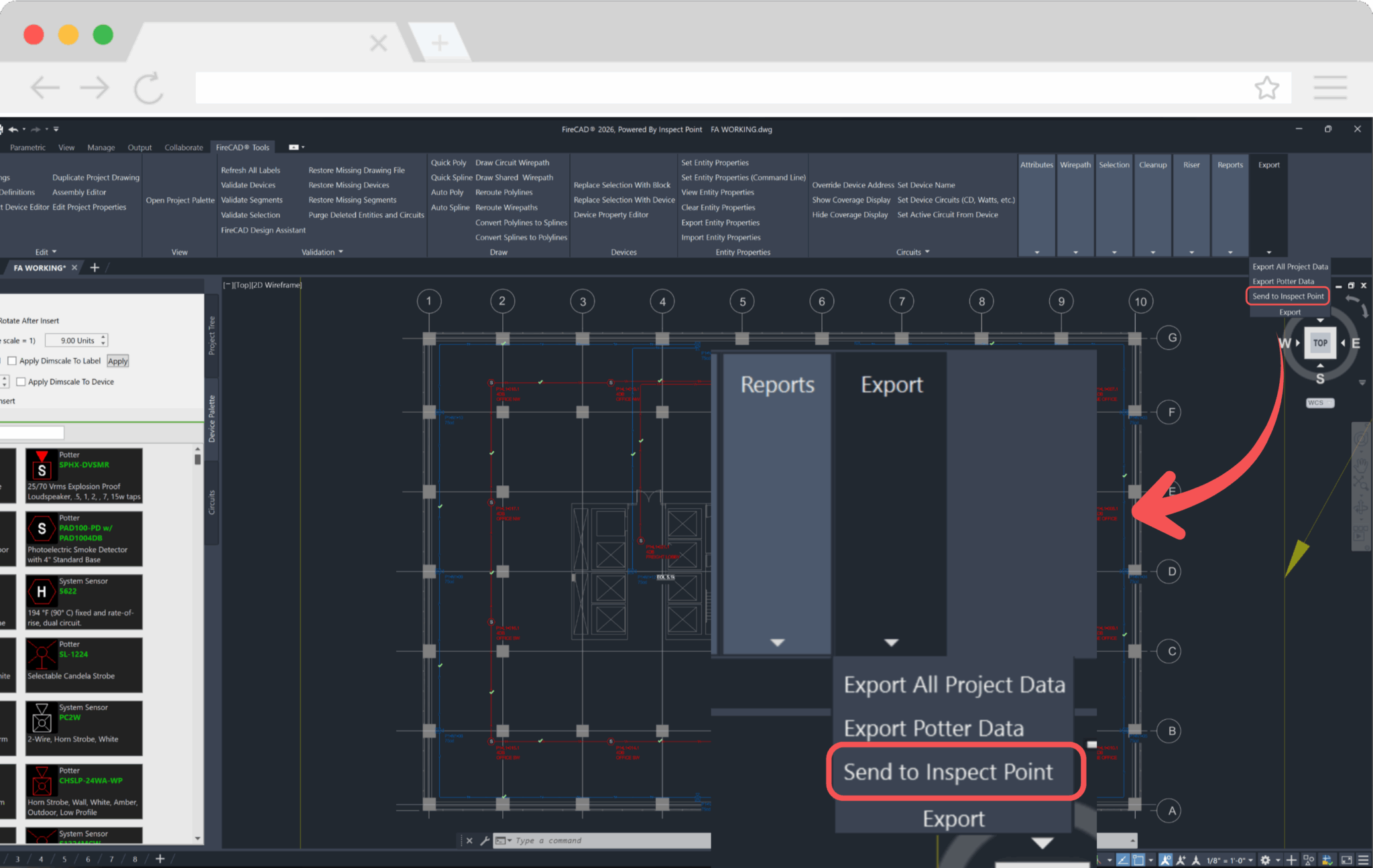
Designing a fire alarm system and inspecting it in the field shouldn’t feel like two different jobs stitched together with spreadsheets. Yet for many teams, that’s the day-to-day: CAD drawings live in one world; inspection scheduling, device lists, and compliance live in another. The gap between them gets filled with manual re-entry, CSV exports, and “did we get the latest version?” messages. Small mismatches — an address change here, a device swap there — compound into delays, return visits, and costly rework.
We’ve seen it up close. When design data doesn’t move cleanly to the field, the project timeline stalls. Inspectors arrive with incomplete or outdated lists. PMs scramble to reconcile discrepancies. Technicians improvise on site. AHJs ask for clarifications. Revenue waits. The result isn’t just inefficiency — it’s risk.
That’s the problem we set out to solve with the Inspect Point × FireCAD integration.
The handoff problem (and why it persists)
The design-to-inspection handoff breaks down in three predictable ways:
- Data drift: A device spec is updated in the CAD file, but the spreadsheet powering inspections isn’t. Hours (or days) later, someone realizes they’re out of sync.
- Manual bottlenecks: Teams export BOMs, massage fields, reformat, import—and repeat. This adds overhead and introduces error pathways.
- Fragmented accountability: When the source of truth moves around, so does ownership. It’s harder to know which list to trust or who has the latest version.
These aren’t edge cases. They’re the default when design and inspection live in different systems without a reliable, automated bridge.
What changes with Inspect Point × FireCAD
Following Inspect Point’s acquisition of FireCAD, our teams built a native connection to close the loop—so the data you design with becomes the data your field teams inspect against.
1) One-Click Design-to-Inspection Sync
Device data created in FireCAD — type, make, model, address, zone — flows straight into Inspect Point. Create inspection-ready device lists, schedule work, and track assets without intermediate spreadsheets.
2) No Manual Re-Entry
Say goodbye to CSV shuffles and copy-paste. The integration moves structured data securely between systems, cutting administrative time and reducing transcription errors.
3) Single Source of Truth
Everyone — designers, inspectors, technicians, and PMs—works from the same verified dataset across the project lifecycle. When design updates, inspection reflects it.
Who benefits (and how)
- Designers: Less administrative overhead; fewer clarification emails; confidence that your intent carries to the field.
- Inspectors & Technicians: Accurate, complete device lists; clearer routes; fewer return trips.
- Project Managers: Real-time status and fewer delays at the most fragile point in the timeline.
- Operations Leaders: Standardized process, better throughput, and cleaner reporting for compliance and profitability.
- IT/Admins: Fewer custom scripts and one-off imports to maintain.
A day-in-the-life: From submittal to first inspection
- Design: Your team builds the system in FireCAD. Devices are placed with rich metadata — addressable loop, model numbers, locations, and zones.
- Sync: With one action, FireCAD pushes that device list into Inspect Point.
- Plan: Inspections are scheduled directly from the synced list so teams have insight into what’s planned and what’s left.
- Field: Technicians use Inspect Point to complete inspections against the exact set of devices designed — no guesswork.
- Closeout: Results flow back to reports and dashboards. If design changes, the next sync keeps inspection aligned.
The handoff becomes a handshake.
Implementation: What it takes
- Enable the integration: Your Inspect Point and FireCAD account teams will help toggle the connection and confirm data mappings.
- Align your templates: Ensure your FireCAD device attributes (model, address, zone, etc.) match how you track assets in Inspect Point.
- Pilot on an active project: Start with a controlled rollout to validate the flow, then standardize it across your portfolio.
- Train for the new “one-click” habit: Replace manual exports with the sync. Build it into your design QA checklist.
Why now
Markets are tighter, timelines are shorter, and AHJ expectations aren’t getting simpler. Integrations that remove variability — and the risk hiding inside it — are no longer a nice-to-have. They’re an operational advantage. With FireCAD now part of Inspect Point, we’re investing to make the design → inspection → service loop not just faster, but measurably better.
About FireCAD, powered by Inspect Point
FireCAD is a CAD platform built specifically for fire protection design — fast layout, clean documentation, and submission-ready deliverables.
Together, we’re building the connected workflow fire protection teams have been asking for.

